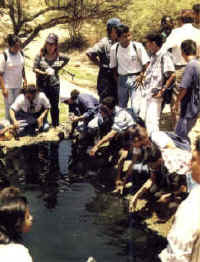MARCAVELICA - AGUA DE LA LECHE
|
|
|
LAGUNA "AGUA DE LA LECHE"
Según apunte de don Rodolfo Cruz Merino, los baños de la leche, o baños de Santa Ana, jamás han sido una laguna. Quizá, por la bondad curativa tanto de su agua, como de su barro, alguien entreverado con los quehaceres turísticos, los asoció a la Huacachina para exaltar su atractivo, pero sigue siendo un manantial, una breve quebradilla, cuyas coordenadas geográficas son 80º 52’ 55” de longitud oeste y 4º 38’ 15” de latitud sur. Su altura sobre el nivel del mar es de 400 metros. Partiendo
de Sullana se llega al sitio por dos vías: una sale de Cerro Mocho y
resulta muy larga; mientras que la otra,
arranca pasando el puente Samán, torciendo a la derecha y
recorriendo hasta las inmediaciones de Cañas; se dobla a la izquierda,
enrumbando por la quebrada de Casura para alcanzar Jaguay Grande, donde
existe una casa y cerca, el manantial
buscado. El
manantial fue denunciado y explotado por el inquieto hombre de empresas
mineralogista, don Hermenegildo Vargas, quién construyera allí un
albergue –del que quedan en la actualidad solamente ruinas- y algunas
pozas donde se juntaba el agua medicinal, para que se bañaran los
visitantes. El agua tiene marcado olor sulfhídrico manteniendo
disueltos y en suspensión, una gama de sulfuros, que levemente colorean
de amarillo las orillas de la fuente. Es por esta razón que posee acción
curativa en algunas afecciones dermatológicas y es usada en
balneoterapia, propiedad que quiso aprovechar este pionero del turismo y
de la prospección
que fue don Hermenegildo. En diferentes partes de las laderas brota
tenuemente el agua y luego, discurriendo, se reúne en el cauce del
arroyo que agoniza mansamente tras recorrer medio kilómetro. Gran parte
del lecho está cubierto de tierra, razón por la que el agua no aflora
en la totalidad del recorrido, desapareciendo, para emerger un trecho más
adelante En
las primeras horas de la mañana la superficie del agua se torna
blanquecina, por la precipitación de algunos sulfuros que luego
sobrenadan, lo que explica la toponimia láctea: agua de la leche,
rebautizada más tarde como Baños de Santa Ana, por el propio don
Hermenegildo, en homenaje a su esposa doña Ana Rosa Merino de Vargas. Cerca
hay un pequeño cañón por el que baja en suave catarata, una vertiente
de aguas cristalinas, con caracteres organolépticos distintos a los de
la fuente, agua que hace un tiempo fue embotellada con el nombre de agua
mineral Santa Julia. Mas
allá, a la derecha, en una depresión de las rocas, hay un charco de
fresca agua dulce, al que llaman la Poza de los Españoles, pues, según
la tradición, en ella se bañaban a su paso los conquistadores. Son
muchas las propiedades curativas atribuidas a esta agua y a su barro:
desde el acné hasta la verruga plana juvenil, habiéndose dado el caso
donde, lo que la nieve carbónica no erradicaba, ellas si lo lograron
desde el primer baño, desprendiéndose las múltiples verrugas planas
que habían invadido el rostro y el dorso de las manos.
|
LAGOON "DILUTES OF THE MILK"
According to gift note Rodolfo Cruz Merino, the bathrooms of the milk, or bathrooms of Santa Ana, they have never been a lagoon. Maybe, for the kindness healing point of their water, as of their mud, somebody related with the tourist chores, associated them to the Huacachina to exalt their attractiveness, but it continues being a spring, a brief gulch whose coordinated geographical they are 80º 52 ' 55” of longitude west and 4º 38 ' 15” of south latitude. Its height on the level of the sea is of 400 meters.Leaving Sullana you arrives to the place for two roads: one leaves Blunt Hill and it is very long; while the other one, pulls up passing the bridge Samán, turning to the right and traveling until the vicinity of Canes; turns to the left, continuing for the gulch of Casura to reach Big Jaguay, where it exists a house and fence, the looked for spring. |
LAGUNE "VERDÜNNT VON DER MILCH" Geschenk-Notiz zufolge Rodolfo Cruz Merino, die Badezimmer der Milch, oder Badezimmer von Santa Ana, sie sind nie eine Lagune gewesen. Vielleicht, denn die Freundlichkeit, die Punkt ihres Wassers heilt, als von ihrem Schlamm erzählte jemand mit den Tourist-lästigen Arbeit, assoziierte sie zum Huacachina, um ihre Attraktivität zu erhöhen, aber es setzt Sein ein Frühling fort, eine kurze Bergschlucht, wessen geographisch koordinierte, sie sind 80º 52 ' 55” von Länge West und 4º 38 ' 15” von Süden-Breite. Seine Höhe auf dem Niveau des Meeres ist Sie von 400 meters.Leaving Sullana, kommt zur Stelle für zwei Straßen an: man verläßt Stumpfen Hügel, und es ist sehr lang; während das andere, hält an, reicht der Brücke Samán, dreht zum Recht und reist bis die Umgebung von Spazierstocken; Drehungen zur Linke, das Fortsetzen für die Bergschlucht von Casura, um Großen Jaguay zu erreichen, wo es ein Haus existiert und ficht, die sahen Frühling. |
